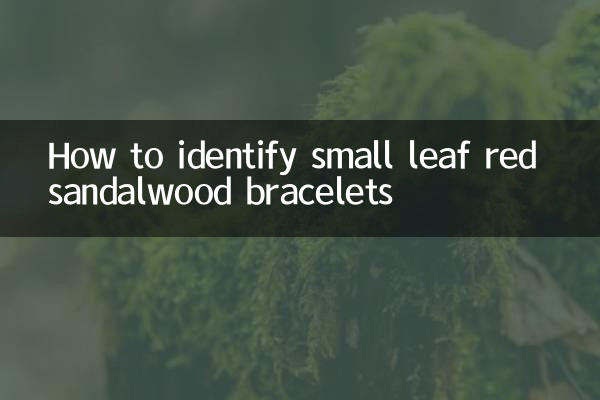How to identify small-leafed red sandalwood bracelets
Pterocarpus santalinus (scientific name: Pterocarpus santalinus) is popular among cultural and entertainment enthusiasts because of its hard wood, delicate texture and deep color. However, there are many imitations on the market, and how to distinguish between real and fake has become the focus of consumers' attention. This article will be fromColor, texture, smell, density, priceIn other dimensions, combined with popular topics on the entire network for the past 10 days, it provides you with a systematic identification guide.
1. Hot topic background

Recently, the number of discussions on social platforms about "anti-artistic play anti-counterfeiting" and "small-leaf red sandalwood dyeing scam" has surged. Data shows that the search volume of the following keywords increased month-on-month:
| Keywords | Search volume increase | Related hot events |
|---|---|---|
| Identification of small-leaf red sandalwood | 320% | A certain internet celebrity sells fake sales in a live broadcast room exposed |
| Blood Sandalwood impersonates purple Sandalwood | 180% | CCTV 315 Special Report |
| Rosewood Venus is true or false | 150% | Industry associations release new appraisal standards |
2. Core identification method
By comparing the characteristics of genuine products and common imitations, the following identification points can be summarized:
| Identification dimensions | Authentic features | Features of imitation |
|---|---|---|
| color | After oxidation, it is dark purple-red, and the white stubble-stage orange-red | The color is dull after dyeing, and the color fades white |
| Texture | The cow's hair is fine and natural, and the Venus is irregularly distributed | Thick or artificial lines, Venus is arranged neatly |
| odor | Light sandalwood, with a clear aroma when polished | Pungent or odorless |
| density | Submerged (density 1.05-1.26g/cm³) | Some imitations are suspended or semi-sinked |
| price | 18mm bracelet market price 800-3000 yuan | More than 500 yuan is a copy |
3. Advanced identification skills
1.Alcohol test method: Take the wood chips and put them in alcohol. The authentic product will precipitate orange-red gum, and the stained wood will not respond.
2.UV detection: Under the 365nm ultraviolet lamp, the genuine fluorescence reaction is weak, and the stained blood sandalwood will show strong blue fluorescence.
3.Certificate verification: Regular channels should provide CMA certification certification certificates, and you can scan the QR code to verify authenticity.
4. Consumer warning data
According to the latest statistics from the Consumer Association, complaints about Xiaoye Rosewood are mainly focused on the following aspects:
| Complaint Type | Percentage | Typical cases |
|---|---|---|
| Imitate the blood sandalwood | 42% | A certain e-commerce platform "Emperor Rose Sandalwood" is actually an African blood sandalwood |
| Artificial Venus fake | 35% | Gold powder glue filling to make fake golden stars |
| Dyeing to make old | twenty three% | Chemical dyeing + high-temperature baking forged old materials |
5. Purchase suggestions
1. Priority is given to physical stores, and details can be observed on-site.
2. Request the merchant to issue a timber tree species identification certificate
3. Avoid buying exaggerated promotional products such as "full of Venus" and "Chicken Blood Red"
4. Newbie recommend starting with the basics and gradually accumulating identification experience.
Mastering these identification methods can effectively reduce purchasing risks. It is worth reminding that the so-called "Indian Leaf Rosewood" on the market are mostly hype concepts. According to the CITES Convention, the trade in real Indian Leaf Rosewood is strictly restricted, and it is more difficult for ordinary consumers to access genuine products.

check the details

check the details